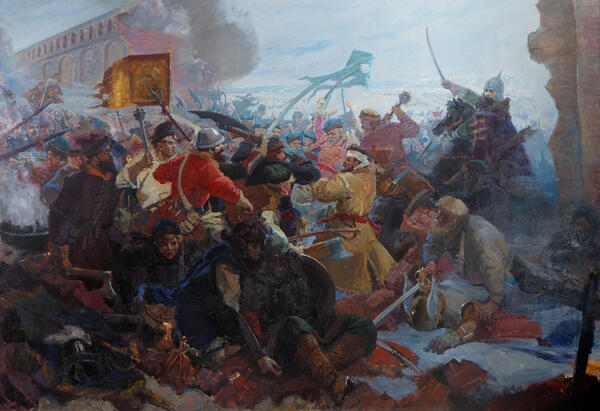The halls of the new exposition ‘A Journey of a Thousand Years’ hold more than 2000 museum exhibits that clearly represent more than 500 years of original, heroic history of the region, and a significant part of them are exhibited for the first time. The jewel of the exposition is the original preserved mammoth skeleton.
In the halls, visitors can see the archaeological monuments of the Gnezdovsky complex (9th-10th centuries): a large-pot amphora with the most ancient Russian inscription that has no analogues in the world, the famous Frankish steel swords, rare gold coins, bronze and brass jewelry, fibulas and buckles.
The exhibition halls display unique archaeological monuments of ancient Smolensk (9th-13th centuries): the stone tomb of Prince Davyd Rostislavich, Smolensk birchbark manuscripts, weapons of Russian knights, frescoes from Smolensk churches. One can get acquainted with the objects of everyday life of the ancient Smolensk people, see a fragment of an 800-year-old house, voluminous models of ancient temples of Smolensk.
The exposition reflects the highlights of Smolensk history: the Mongol-Tatar invasion of the 13th century; relationship with the Grand Duchy of Lithuania in the 13th-15th centuries; the collection of Russian lands and the return of Smolensk to the Russian state in 1514; construction of the Smolensk fortress wall in 1596-1602; the heroic defense of Smolensk from the Polish invaders; the final liberation of the Smolensk land in 1654; the reforms of Peter I at the beginning of the 18th century; participation of the Smolensk region in the Northern War; formation and development of the Smolensk province.
In the halls, visitors can see the archaeological monuments of the Gnezdovsky complex (9th-10th centuries): a large-pot amphora with the most ancient Russian inscription that has no analogues in the world, the famous Frankish steel swords, rare gold coins, bronze and brass jewelry, fibulas and buckles.
The exhibition halls display unique archaeological monuments of ancient Smolensk (9th-13th centuries): the stone tomb of Prince Davyd Rostislavich, Smolensk birchbark manuscripts, weapons of Russian knights, frescoes from Smolensk churches. One can get acquainted with the objects of everyday life of the ancient Smolensk people, see a fragment of an 800-year-old house, voluminous models of ancient temples of Smolensk.
The exposition reflects the highlights of Smolensk history: the Mongol-Tatar invasion of the 13th century; relationship with the Grand Duchy of Lithuania in the 13th-15th centuries; the collection of Russian lands and the return of Smolensk to the Russian state in 1514; construction of the Smolensk fortress wall in 1596-1602; the heroic defense of Smolensk from the Polish invaders; the final liberation of the Smolensk land in 1654; the reforms of Peter I at the beginning of the 18th century; participation of the Smolensk region in the Northern War; formation and development of the Smolensk province.

